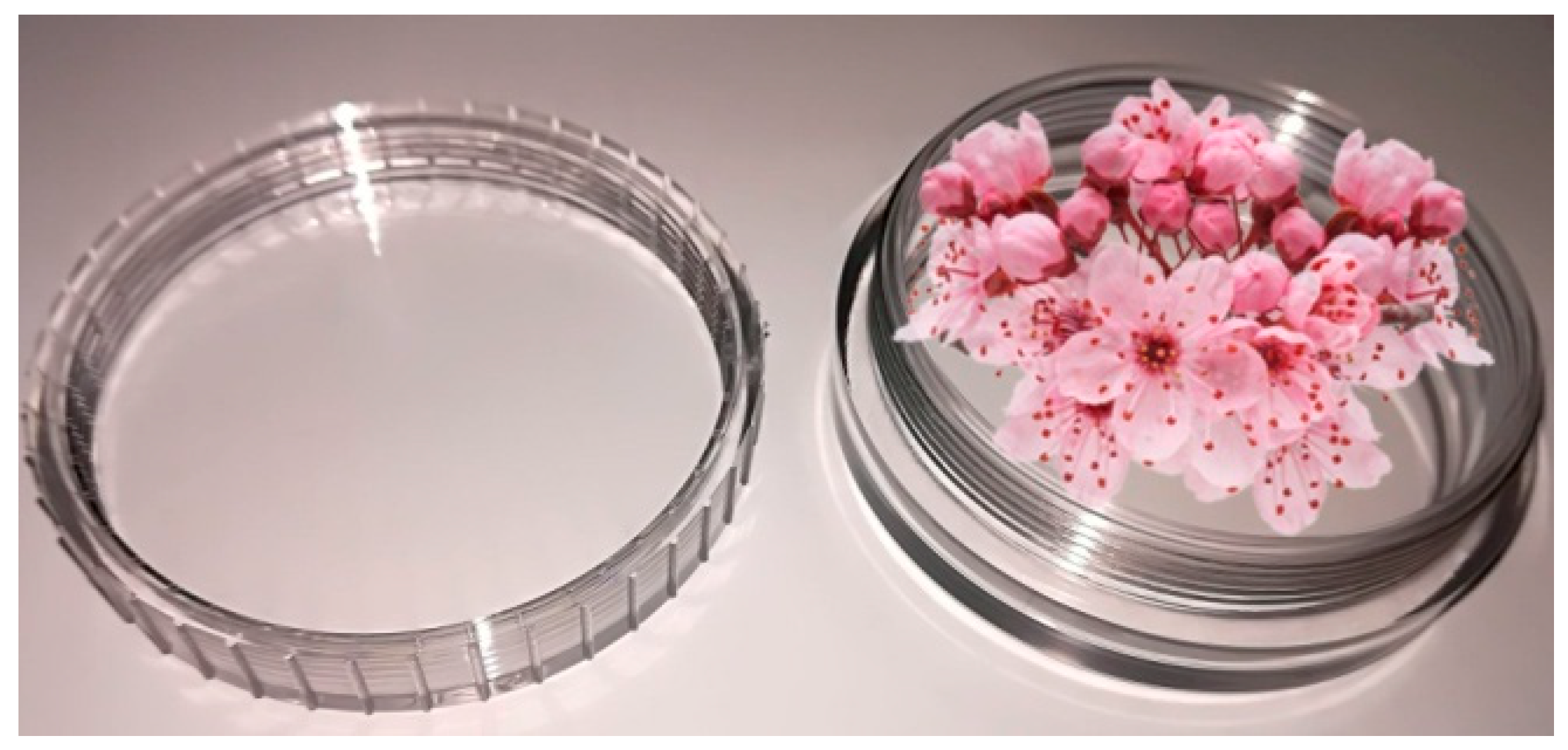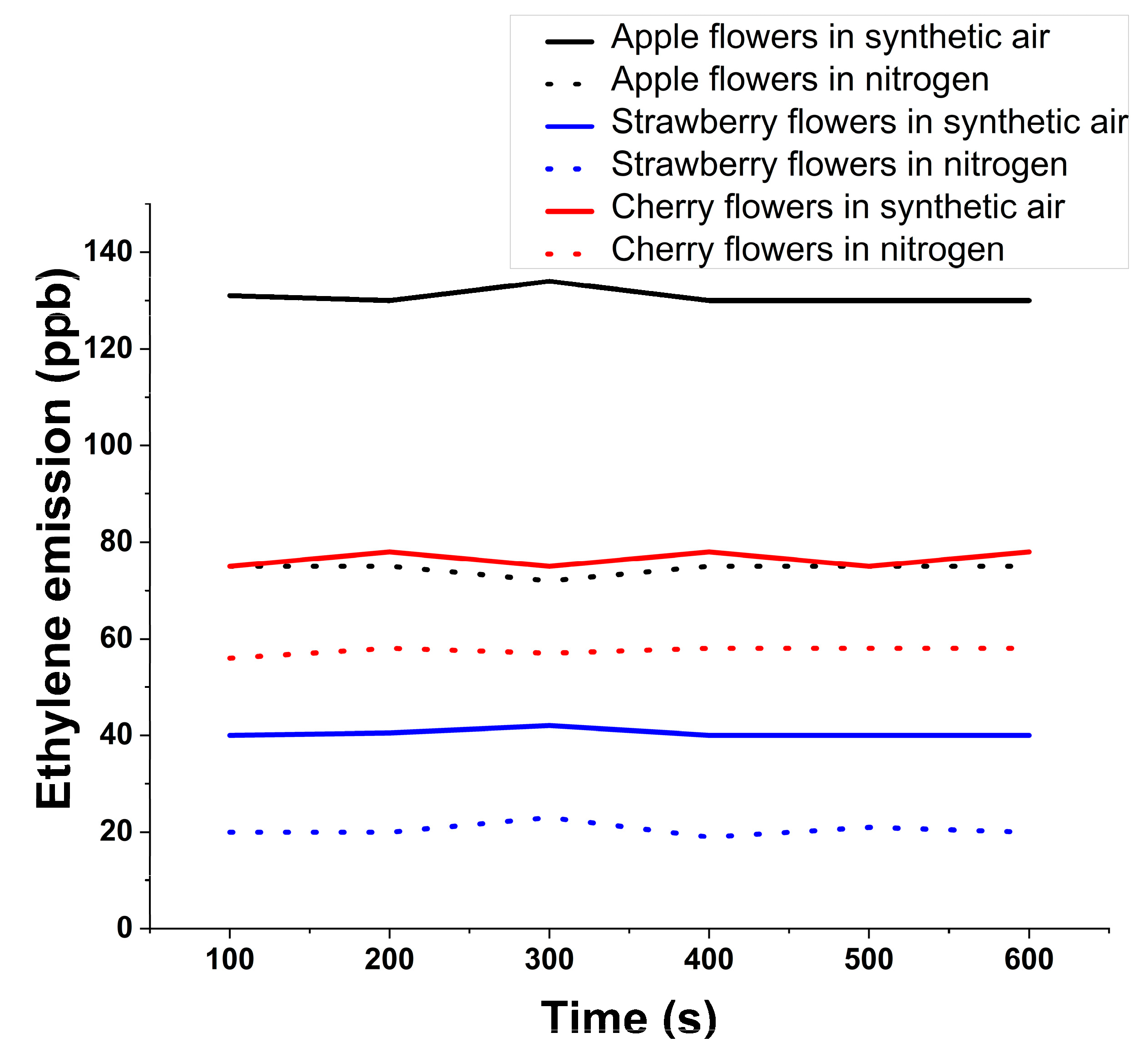Ethylene Measurements from Sweet Fruits Flowers Using Photoacoustic Spectroscopy
Abstract
:1. Introduction
2. Materials and Methods
3. Results and Discussion
3.1. Results for Flower Tissue Respiration
3.2. Discussion
4. Conclusions
Funding
Acknowledgments
Conflicts of Interest
References
- Harren, F.J.; Cristescu, S.M. Online, real-time detection of volatile emissions from plant tissue. AoB Plants 2013, 5, plt003. [Google Scholar] [CrossRef] [PubMed]
- Bratu, A.M.; Popa, C.; Matei, C.; Banita, S.; Dutu, D.C.A.; Dumitras, D.C. Removal of interfering gases in breath biomarker measurements. J. Optoelectron. Adv. Mater. 2011, 13, 1045–1050. [Google Scholar]
- Popa, C.; Petrus, M.; Bratu, A.M.; Patachia, M.; Banita, S. Photoacoustic response of cherry tomatoes contaminated with car engines pollution and UV radiation. Optoelectron. Adv. Mat. 2017, 11, 262–266. [Google Scholar]
- Khan, M.I.R.; Trivellini, A.; Fatma, M.; Masood, A.; Francini, A.; Lqbal, N.; Ferrante, A.; Khan, N.A. Role of ethylene in responses of plants to nitrogen availability. Front. Plant Sci. 2015, 6, 927. [Google Scholar] [CrossRef] [PubMed]
- Iqbal, N.; Khan, N.A.; Nazar, R.; Silva, J.A. Ethylene-stimulated photosynthesis results from increased nitrogen and sulfur assimilation in mustard types that differ in photosynthetic capacity. Environ. Exp. Bot. 2011, 78, 84–90. [Google Scholar] [CrossRef]
- Iqbal, N.; Khan, N.A.; Ferrante, A.; Trivellini, A.; Francini, A.; Khan, M.I.R. Ethylene Role in Plant Growth, Development and Senescence: Interaction with Other Phytohormones. Front. Plant Sci. 2017, 8, 475. [Google Scholar] [CrossRef]
- Khan, M.I.R.; Khan, N.A. Ethylene reverses photosynthetic inhibition by nickel and zinc in mustard through changes in PS II activity, photosynthetic nitrogen use efficiency, and antioxidant metabolism. Protoplasma 2014, 251, 1007–1019. [Google Scholar] [CrossRef]
- Khan, M.I.R.; Nazir, F.; Asgher, M.; Per, T.S.; Khan, N.A. Selenium and sulfur influence ethyleneformation and alleviate cadmium-induced oxidative stress by improving prolineand glutathione production in wheat. J. Plant Physiol. 2014, 173, 9–18. [Google Scholar] [CrossRef]
- Petrus, M.; Bratu, A.M.; Popa, C. Spectroscopic study of dietary effects on volatile breath biomarkers. Rom. Rep. Phys. 2017, 69, 609. [Google Scholar]
- Iqbal, N.; Umar, S.; Khan, N.A. Nitrogen availability regulates proline and ethylene production and alleviates salinity stress in mustard (Brassica juncea). J. Plant Physiol. 2015, 178, 84–91. [Google Scholar] [CrossRef]
- Li, Y.S.; Mao, X.T.; Tian, Q.Y.; Li, L.H.; Zhang, W.H. Phosphorus deficiency induced reduction in root hydraulic conductivity is mediated by ethylene in Medicago falcate. Environ. Exp. Bot. 2009, 67, 172–177. [Google Scholar] [CrossRef]
- Jung, J.Y.; Shin, R.; Schachtman, D.P. Ethylene mediates response and tolerance to potassium deprivation in Arabidopsis. Plant Cell 2009, 21, 607–621. [Google Scholar] [CrossRef] [PubMed]
- Petrus, M. Ammonia and ethylene measurements in pure nitrogen. Rom. J. Phys. 2016, 61, 1539–1546. [Google Scholar]
- Dorling, S.L.; Leung, S.; Anderson, C.W.N.; Albert, N.W.; McManus, M.T. Changes in 1-aminocyclopropane-1-carboxlate (ACC) oxidase expression and enzyme activity in response to excess manganese in white clover (Trifoliumrepens L.). Plant Physiol. Biochem. 2011, 49, 1013–1019. [Google Scholar] [CrossRef]
- Arteca, R.N.; Arteca, J.N. Heavy-metal-induced ethylene production in Arabidopsis thaliana. J. Plant Physiol. 2007, 164, 1480–1488. [Google Scholar] [CrossRef]
- Iqbal, N.; Trivellini, A.; Masood, A.; Ferrante, A.; Khan, N.A. Current understanding on ethylene signaling in plants: The influence of nutrient availability. Plant Physiol. Biochem. 2013, 73, 128–138. [Google Scholar] [CrossRef] [PubMed]
- Yang, S.F.; Hoffman, N.E. Ethylene Biosynthesis and its Regulation in Higher Plants. Annu. Rev. Plant Phys. 1984, 35, 155–189. [Google Scholar] [CrossRef]
- Popa, C.; Bratu, A.M.; Dumitraş, D.C.; Paţachia, M.; Băniţă, S. Photoacoustic detection of ethylene concentration in cherry tomatoes. J. Optoelectron. Adv. Mater. 2014, 16, 82–86. [Google Scholar]
- Banita, S.; Dumitras, D.C.; Bratu, A.M.; Patachia, M.; Popa, C. Ethylene production of organic and nonorganic mature mushrooms measured by LPAS. Rom. Rep. Phys. 2014, 66, 887–892. [Google Scholar]
- Huelin, F.E.; Barker, J. The effect of ethylene on the respiration and carbohydrate metabolism of potatoes. New Phytol. 2006, 38, 2. [Google Scholar] [CrossRef]
- Ketring, D.L.; Morgan, P.W. Ethylene as a component of the emanations from germinating peanut seeds and its effect on Dormant Virginia-type Seeds. Laiit. Pliysiol. 1969, 44, 326–330. [Google Scholar] [CrossRef]
- Burg, S.P. The Physiology of Ethylene Formation. Annu. Rev. Plant Phys. 1962, 13, 265–302. [Google Scholar] [CrossRef]
- Denny, F.E. Effect of ethylene upon respiration of lemons. Bot. Gaz. 1924, 77, 322–329. [Google Scholar] [CrossRef]
- Wolfe, H.S. Effect of ethylene on ripening bananas. Bot. Gaz. 1931, 92, 337–366. [Google Scholar] [CrossRef]
- Overholser, E.L. A study of the harvesting and storage of gravenstein apples. Ame. Soc. Hort. Sci. Proc. 1927, 24, 252–255. [Google Scholar]
- Allen, F.W. The influence of ethylene gas treatment upon the coloring and ripening of apples and pears. Ame. Soc. Hort. Sci. Proc. 1930, 27, 43–50. [Google Scholar]
- Wang, K.L.C.; Li, H.J.R. Ethylene Biosynthesis and Signaling Networks. Plant Cell 2002, 14, s131–s151. [Google Scholar] [CrossRef]
- Barry, C.S.; Llop-Tous, M.I.; Grierson, D. The regulation of 1-aminocyclopropane-1-carboxylic acid synthase gene expression during the transition from system-1 to system-2 ethylene synthesis in tomato. Plant Physiol. 2000, 123, 979–986. [Google Scholar] [CrossRef]
- Dumitras, D.C.; Banita, S.; Bratu, A.M.; Cernat, R.; Dutu, D.C.A.; Matei, C.; Patachia, M.; Petrus, M.; Popa, C. Ultrasensitive CO2 laser photoacoustic system. Infrared Phys. Tech. J. 2010, 53, 308–314. [Google Scholar] [CrossRef]
- Dumitras, D.C.; Dutu, D.C.; Matei, C.; Magureanu, A.M.; Petrus, M.; Popa, C. Laser photoacoustic spectroscopy: Principles, instrumentation, and characterization. J. Optoelectron. Adv. Mater. 2007, 9, 3655–3701. [Google Scholar]
- Krapp, A. Plant nitrogen assimilation and its regulation: A complex puzzle with missing pieces. Curr. Opin. Plant Biol. 2015, 25, 115–122. [Google Scholar] [CrossRef] [PubMed]
- Gastal, F.; Lemaire, G. N uptake and distribution in crops: An agronomical and ecophysiological perspective. J. Exp. Bot. 2002, 53, 789–799. [Google Scholar] [CrossRef]
- Tian, Q.Y.; Sun, P.; Zhang, W.H. Ethylene is involved in nitrate-dependent root growth and branching in Arabidopsis thaliana. New Phytol. 2009, 184, 918–931. [Google Scholar] [CrossRef] [PubMed]
- Popa, C.; Dumitraş, D.C.; Paţachia, M.; Băniţă, S. Testing fruits quality by photoacoustic spectroscopy assay. Laser Physics. 2014, 24, 10–1088. [Google Scholar] [CrossRef]
- Mogildea, G.; Mogildea, M. Experimental investigation of the microwave electrothermal thruster using metals as propellant. Optoelectron. Adv. Mat. 2010, 4, 1826–1829. [Google Scholar]
- Mogildea, M.; Mogildea, G. Experimental research for the mass flow control of the metal vaporized and ionized with microwave used in electric propulsion. Optoelectron. Adv. Mat. 2010, 12, 1157–1160. [Google Scholar]
- Werle, P. A review of recent advances in semiconductor laser based gas monitors. Spectrochim. Acta A 1998, 54, 197–236. [Google Scholar] [CrossRef]
- Miklos, A.; Hess, P.; Bozoki, Z. Application of acoustic resonators in photoacoustic trace gas analysis and metrology. Rev. Sci. Instrum. 2001, 72, 1937–1955. [Google Scholar] [CrossRef]
- Cristescu, S.M.; De Martinis, D.; Hekkert, S.T.; Parker, D.H.; Harren, F.J.M. Ethylene production by Botrytis cinerea in vitro and in tomatoes. Appl. Environ. Microb. 2002, 68, 5342–5350. [Google Scholar] [CrossRef]
- Cristescu, S.M.; Persijn, S.T.; Hekkert, S.T.L.; Harren, F.J.M. Laser-based systems for trace gas detection in life sciences. Appl. Phys. B 2008, 92, 343–349. [Google Scholar] [CrossRef]
- Harren, F.J.M.; Mandon, J.; Cristescu, S.M. Photoacoustic spectroscopy in trace gas monitoring. In Encyclopedia of Analytical Chemistry; Meyers, R.A., Ed.; Wiley: Chichester, UK, 2012. [Google Scholar]
- Bratu, A.M.; Petrus, M.; Popa, C. Laser-based spectrometer for optical trace gas detection in young adults with autism. Microchem. J. 2018, 138, 203–208. [Google Scholar] [CrossRef]
- Dumitras, D.C.; Bratu, A.M.; Popa, C. CO2 Laser Photoacoustic Spectroscopy: Principles. In CO2 Laser-Optimisation and Application; Intech Open: London, UK, 2012; ISBN 979-953-307-712-2. [Google Scholar]
- Bratu, A.M. Spectroscopic study of breath ethylene via the mouth and nose. Laser Med. Sci. 2018, 1–6. [Google Scholar] [CrossRef]
- Gordon, I.E.; Rothman, L.S.; Hill, C.; Kochanov, R.V.; Tan, Y.; Bernath, P.F.; Birk, M.; Boudon, V.; Campargue, A.; Chance, K.V.; et al. The HITRAN2016 molecular spectroscopic database. J. Quant. Spectrosc. Ra. 2017, 203, 3–69. [Google Scholar] [CrossRef]
- Brown, S.S. Absorption spectroscopy in high-finesse cavities for atmospheric studies. Chem. Rev. 2003, 103, 5219–5238. [Google Scholar] [CrossRef] [PubMed]
- Berden, G.; Peeters, R.; Meijer, G. Cavity ring-down spectroscopy: Experimental schemes and applications. Int. Rev. Phys. Chem. 2000, 19, 565–607. [Google Scholar] [CrossRef]
- Popa, C.; Petrus, M.; Bratu, A.M. Ammonia and ethylene biomarkers in the respiration of the people with schizophrenia using photoacoustic spectroscopy. J. Biomed. Opt. 2015, 20, 057006. [Google Scholar] [CrossRef]
- Druege, U. Influence of pre-harvest nitrogen supply on post-harvest behaviour of ornamentals: Importance of carbohydrate status, photosynthesis and plant hormones. Gartenbauwissenschaft 2000, 65, 53–64. [Google Scholar]
- Fiebig, A.; Dodd, I.C. Inhibition of tomato shoot growth by over-irrigation is linked to nitrogen deficiency and ethylene. Physiol. Plant 2015, 156, 70–83. [Google Scholar] [CrossRef] [PubMed]
- Khan, N.A.; Mir, M.R.; Nazar, R.; Singh, S. The application of ethephon (an ethylene releaser) increases growth, photosynthesis and nitrogen accumulation in mus-tard (Brassica juncea L.) under high nitrogen levels. Plant Biol. 2008, 10, 534–538. [Google Scholar] [CrossRef]
- Iqbal, N.; Nazar, R.; Syeed, S.; Massod, A.; Khan, N.A. Exogenously-sourced ethylene increases stomatal conductance, photosynthesis, and growth under optimal and deficient nitrogen fertilization in mustard. J. Exp. Bot. 2011, 62, 4955–4963. [Google Scholar] [CrossRef] [Green Version]
- Ren, W.; Li, D.; Liu, H.; Mi, R.; Zhang, Y.; Dong, L. Lithium storage performance of carbon nanotubes with different nitrogen contents as anodes in lithium ions batteries. Electrochi. Acta 2013, 105, 75–82. [Google Scholar] [CrossRef]
- Legé, K.E.; Cothren, J.T.; Morgan, P.W. Nitrogen fertility and leaf age effect on ethylene production of cotton in a controlled environment. Plant. Growth Regul. 1997, 22, 23–28. [Google Scholar] [CrossRef]
- Lea, U.S.; Slimestad, R.; Smedvig, P.; Lillo, C. Nitrogen deficiency enhances expression of specific MYB and bHLH transcription factors and accumulation of end products in the flavonoid pathway. Planta 2007, 225, 1245–1253. [Google Scholar] [CrossRef] [PubMed]
- Cvikrová, M.; Binarová, P.; Eder, J.; Vágner, M.; Hrubcová, M.; Zoń, J. Effect of inhibition of phenylalanine ammonia-lyase activity on growth of alfalfa cell suspension culture: Alterations in mitotic index, ethylene production, and contents of phenolics, cytokinins and polyamines. Physiol. Plant. 1997, 107, 329–337. [Google Scholar] [CrossRef]
- Davies, F.T.; He, C.; Chau, A.; Heinz, K.M.; Cartmill, A.D. Fertility affects susceptibility of chrysanthemum to cotton aphids: Influence on plant growth, photosynthesis, ethylene evolution, and herbivore abundance. J. Am. Soc. Hortic. Sci. 2004, 129, 344–353. [Google Scholar] [CrossRef]
- Kosterev, A.; Wysocki, G.; Bakhirkin, Y.; So, S.; Lewicki, R.; Fraser, M.; Tittel, F.; Curl, R.F. Application of quantum cascade lasers to trace gas analysis. Appl. Phys. B 2008, 90, 165–176. [Google Scholar] [CrossRef]
- Tittel, F.K.; Richter, D.; Fried, A. Mid-infrared laser applications in spectroscopy. In Solid-State Mid-Infrared Laser Sources; Springer: Berlin, Germany, 2003. [Google Scholar]
- Werle, P.; Miicke, R.; Slemr, F. The limits of signal averaging in atmospheric trace-gas monitoring by tunable diode-laser absorption spectroscopy (TDLAS). Appl. Phys. B 1993, 57, 131–139. [Google Scholar] [CrossRef]
Sample Availability: Not available. |



| Parameters | Values |
|---|---|
| Resonant cell pressure | ≈1033 mb |
| The total amount of flowers used for determinations | ≈3g |
| CO2 laser line for gas determination | 10P(14); λ = 10.53 μm; α = 30.4 cm−1 atm−1 |
| Synthetic air outflow | Linde gas: 20% oxygen, 80% nitrogen (impurities: hydrocarbons max. 0.1ppmV, nitrogen oxides max. 0.1ppmV) |
| Nitrogen outflow | Linde gas 6.0, purity 99.9999% |
| Working temperature | ≈23–25 °C |
| Glass cell volume | 150 cm3 |
| Resonant cell volume | 1000cm3 |
| The responsivity of the resonant cell | 375 cmV/W |
| Flowers sample time determinations | ≈550 s |
© 2019 by the author. Licensee MDPI, Basel, Switzerland. This article is an open access article distributed under the terms and conditions of the Creative Commons Attribution (CC BY) license (http://creativecommons.org/licenses/by/4.0/).
Share and Cite
Popa, C. Ethylene Measurements from Sweet Fruits Flowers Using Photoacoustic Spectroscopy. Molecules 2019, 24, 1144. https://doi.org/10.3390/molecules24061144
Popa C. Ethylene Measurements from Sweet Fruits Flowers Using Photoacoustic Spectroscopy. Molecules. 2019; 24(6):1144. https://doi.org/10.3390/molecules24061144
Chicago/Turabian StylePopa, Cristina. 2019. "Ethylene Measurements from Sweet Fruits Flowers Using Photoacoustic Spectroscopy" Molecules 24, no. 6: 1144. https://doi.org/10.3390/molecules24061144



.jpg)


